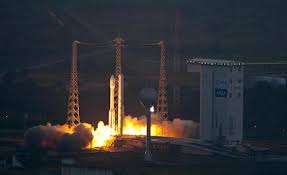A new European mission aims to rendezvous a satellite with hazardous space debris to render it harmless by netting it like fish.
The European Space Agency or ESA’s ambitious mission called e.DeOrbit would use a satellite to net space debris and remove it from low Earth orbit.
The agency ‘s Clean Space initiative is studying the e.DeOrbit mission for removing debris, aiming to reduce the environmental impact of the space industry on Earth and space alike.
‘s Clean Space initiative is studying the e.DeOrbit mission for removing debris, aiming to reduce the environmental impact of the space industry on Earth and space alike.
“Decades of launches have left Earth surrounded by a halo of space junk: more than 17,000 trackable objects larger than a coffee cup, which threaten working missions with catastrophic collision. Even a 1 cm nut could hit with the force of a hand grenade,” ESA said.
The only way to control the debris population across key low orbits is to remove large items such as derelict satellites and launcher upper stages.
Such uncontrolled multi-tonne items are not only collision risks but also time bombs: they risk exploding due to leftover fuel or partially charged batteries heated up by orbital sunlight, the agency said.
The resulting debris clouds would make these vital orbits much more hazardous and expensive to use, and follow-on collisions may eventually trigger a chain reaction of break-ups.
reaction of break-ups.
The e.DeOrbit is designed to target debris items in well-trafficked polar orbits, between 800 km to 1000 km altitude.
The first technical challenge the mission will face is to capture a massive, drifting object left in an uncertain state, which may well be tumbling rapidly.
Sophisticated imaging sensors and advanced autonomous control will be essential, first to assess its condition and then approach it.
and advanced autonomous control will be essential, first to assess its condition and then approach it.
Making rendezvous and then steady station-keeping with the target is hard enough but then comes the really difficult part: how to secure it safely ahead of steering the combined satellite and salvage craft down for a controlled burn-up in the atmosphere?
Several capture mechanisms are being studied in parallel to minimise mission risk . Throw-nets have the advantage of scalability – a large enough net can capture anything, no matter its size and attitude.
. Throw-nets have the advantage of scalability – a large enough net can capture anything, no matter its size and attitude.













Add Comment